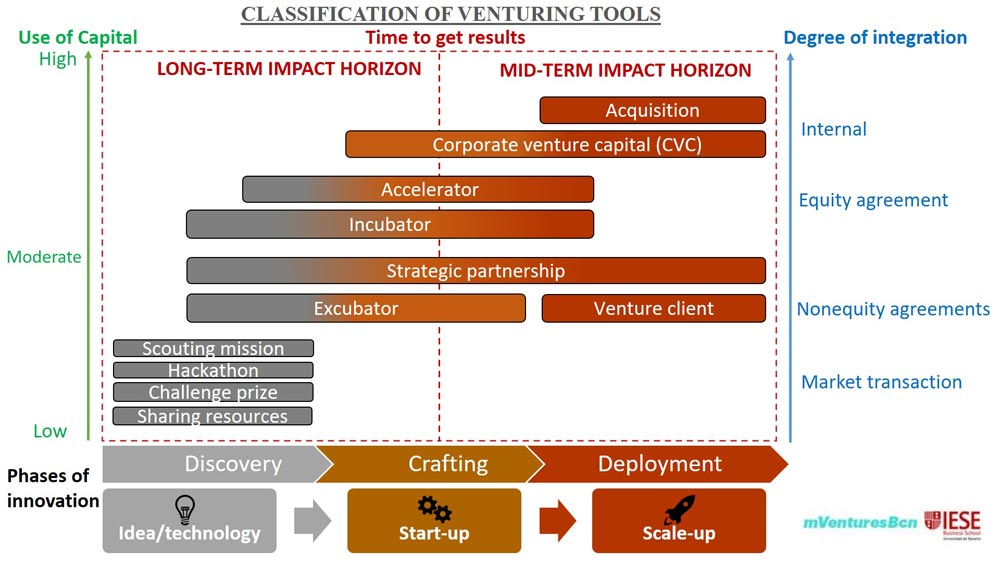A corporation can use one tool or another or all of them, depending on the results that it wishes to obtain, which can go well beyond the financial returns that Corporate Venturing Capital has traditionally represented. New models of cooperation include taking action to acquire or source innovation with a strategical, long-term mindset.
It is important to highlight to avoid confusions, that Corporate Venturing Capital (CVC), probability the oldest and most broadly used Corporate Venturing tool, is just one of the many tools available today. CVC is one particular way of engaging with startups, while Corporate Venturing as a concept covers all the tools. Corporations can use them depending on their situation, strategy, or even the speed of innovation of the industry in which they operate.

Once a firm has decided to pursue a venturing strategy with a clear goal, in the authors’ experience, it faces difficulties identifying the appropriate startups with which to collaborate. Traditionally, knowledge pools such as universities and technology centers have been presented as the places to go for innovation. Although this still holds true, especially for the ideation phase of innovation, a better understanding of the entrepreneurial process has pushed the development of intermediate mechanisms that better support the development of innovative ideas from technology to business opportunities.
Moreover, the affordability of technology in terms of cost, the increased number of skilled people – both those with a mastery of technology and those with entrepreneurial skills – and the speed at which new ideas are spread have resulted in a geographic dispersal of the talent pool from which to source disruptive solutions that might serve corporate needs.
As a result of this diversity and geographic effervescence, new ways of engaging with startups have emerged. Besides internal resources, such as a firm’s connections with the startup ecosystem, its own internal venturing program and many other factors, companies can also leverage with external resources through partnerships with other organizations such as accelerators, venture builders, other corporations or even public institutions with a joint program.
It can be an interesting entry method to the world of corporate venturing for firms that lack knowledge of startups or experience in dealing with them. Joining existing corporate venturing units or dedicated external organizations that have expertise in the field can save a company time and resources compared to doing things on its own. The programs available have expanded rapidly in the past few years as the interaction between corporations and startups has intensified like never before as they have become more aware of the powerful incentives.
Relevant Tools
Today corporate venturing offers a wide range of tools for corporations to come up with disruptive innovations and adapt to the different needs of their innovation strategies: accelerators, incubators, excubators, corporate venture capital, start-up acquisitions, hackathons, scouting missions, strategic partnerships, venturing clients, among others. Each one follows a diverse route to achieve different objectives – from purely direct or indirect financial investments to strategic alliances or support to develop products or services with or without equity investment, including tools such as challenge prizes. We know the question is not whether to capture innovation but how. The programs that the authors explore include traditional tools as well as the latest cutting-edge tools. The new tools have devised with the same goal as their predecessors but they have taken center stage in some corporations’ innovation strategy because of their ambitious approach or features.
The graph summarizes a selection of relevant venturing tools classified by the expected time to affect firm or unit results, the intensity of capital use, the most likely stage in the innovation phase that the tool will be used, and the degree of integration into the established corporation. The classification is a stylized approach to present a complex reality.
Corporations may mix tools according to their goals. Moreover, each tool may show clear variations in how it is implemented. Nevertheless, there is value in defining and describing the most common form for each tool. We set out the tools following the innovation phases –discovery, crafting and deployment.
Here is a brief list and description of the most relevant corporate venturing tools available today:
- Sharing resources: A means to grant startups access to resources while the established corporations get closer to the entrepreneurial ecosystem.
- Challenge prize: An open competition that focuses on a specific issue, offering an incentive to field innovators to develop the best solution.
- Hackathon: A focused workshop where software developers come together to collaboratively find technological solutions to a corporate innovation challenge.
- Scouting mission: The established company appoints an individual within a given industry to scope out innovation opportunities in alignment with the corporate strategy.
- Strategic partnership: Alliances between established corporations and startups can take many forms — including the co-development of products and services and the venture client.
- Excubator: A combination of an incubator and accelerator, it functions as an external venture builder for an established corporation.
- Corporate incubator: mentoring and value-added services to support entrepreneurs building viable, market-ready ideas. It usually focuses on the initial phase, bringing the ideas of the entrepreneurs into real business models.
- Corporate accelerator: Short or medium-term support offered to cohorts of startups via mentoring, education, work space and more. Usually its job consists of giving impetus to already existing business models, to validate them and make them grow.
- Corporate venture capital: Corporations use direct equity investments to target startups of strategic interest.
- Acquisition program: Established firms purchase startups to access their products.
Corporate Venturing post series:
- What is Corporate venturing?
- Why Corporations Need to Collaborate With Startups?
- Tips to Lauch a Corporate Venturing Program
- Success Factors of Corporate Venturing
- A Guide of Corporate Venturing: Tools, Descriptions and Features
This posts are based on: Corporate Venturing: Achieving Profitable Growth Through Startups




nice info .
nice post like
Great Guide.. Thanks For Sharing
Great article full of good info.
Hello
This is great
Thank you so much bother the author of this post